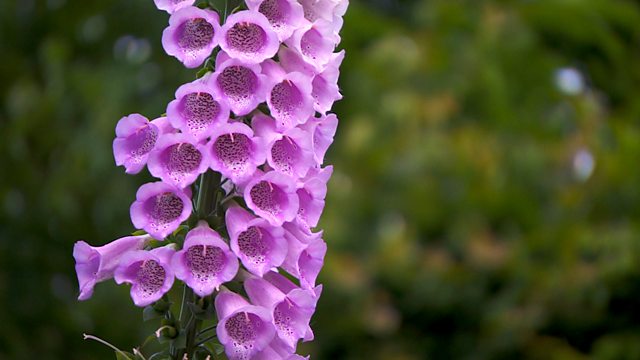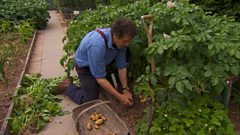
Episode 15
Gardening magazine. Monty Don makes a start on his new wild flower garden at Longmeadow and at last gets to taste the first new potatoes of the year.
Monty Don makes a start on his new wild flower garden at Longmeadow and at last gets to taste the first new potatoes of the year. He also demonstrates how a radical chop of some border plants now can rejuvenate them for later in the season.
Carol Klein celebrates a cottage garden favourite, the foxglove, and Joe Swift drops in on world renowned garden designer, Dan Pearson, to find out what he's got in store for his new garden.
Last on
Clips
-
![]()
Carol’s foxgloves
Duration: 03:22
-
![]()
Monty’s potato trial
Duration: 03:10
The midsummer chop

Hardy geraniums often look a bit scrappy in July once flowering is over. They also have a tendency to sprawl all over the place, which can be annoying when space is at a premium. But if you chop them back now, there’s a good chance they’ll put on plenty of new growth over the summer and even a second flush of flowers. Good candidates include Geranium endressii and its varieties, G. phaeum, ‘Wargrave Pink’, ‘A T Johnson’ and G. x oxonianum. Delphiniums, lupins, lady’s mantle (Alchemilla mollis), catmint (Nepeta) and oriental poppies often respond well too. If the weather turns dry, it’s often worth giving them a good soaking as well, as this will boost your chances of getting a second show of blooms.
Foxglove collection
Terry Baker, the foxglove expert Carol went to see, holds a National Collection of Digitalis on his nursery in Wiltshire. The collection includes a mix of biennials and perennials which look their best in late May/early June. Unfortunately, ‘foxglove week’ has been and gone, but if you’d like to attend next year, check out the website below nearer the time.Ìý
Ìý
The Botanic Nursery
Cottles Lane
Atworth
Melksham
Wiltshire
SN12 8HU
Ìý
National Collection of Digitalis (www.nccpg.com)
Please note that the foxglove plant is toxic so it’s important to wash your hands after handling it.
Garlic harvesting

Unlike onions, garlic is ready to harvest the minute the leaves start to fade and turn yellow. If the crop was planted in the autumn, this could be as early as June or July. But if the bulbs didn’t go in the ground until the spring, August or September is more likely. Whenever it’s ready, make sure you loosen the soil around the bulbs before easing them out with a fork. Handle with care to avoid bruising.
Ìý
Garlic can be stored for several months if it is well dried. The secret is to bake it in the sun until the leaves and skins have turned crispy and dry. Only then should the stalks and roots be cut off, unless you’re going to plait them. Store them in a single layer in a tray, somewhere cool and dry – 5-10ºC (41-50ºF) ideally.
Ìý
This year, Monty’s garlic has been attacked by leek rust – a fungal disease that produces bright orange pustules on both sides of the leaves. Garlic and leeks are particularly susceptible, although the edible parts are rarely affected. Different strains of the fungus are thought to exist, so the level of infection may vary from one part of the country to the next. But it’s interesting thatÌý Monty’s elephant garlic hasn’t succumbed at all, possibly because it is a completely different species to normal garlic.
Ìý
Dan Pearson exhibition
The Garden Museum is holding an exhibition about Dan Pearson’s work until Sunday 20 October. If you’re planning a trip to London over the coming weeks, then why not drop in? The museum is located on the south bank of the Thames next to Lambeth Palace.
Ìý
Garden Museum
Lambeth Palace Road
London
SE1 7LB
Tel. 020 7401 8865
Ìý
Jobs for the weekend: Nip out tomato side-shoots
Cordon (indeterminate) tomatoes, like ‘Gardener’s Delight’, need to be grown with the central stem trained up a bamboo cane or string. As the plant grows, side-shoots will develop in the axil between each leaf and the main stem. Nip these out on a regular basis to prevent the plant from becoming an unproductive, tangled mess.
Ìý
Jobs for the weekend: Ventilate your greenhouse
On a hot, sunny day, the temperature in a greenhouse or conservatory can absolutely rocket. This can do a great deal of damage to plants and, in some cases, may even kill them. Open all doors and as many of the vents or windows as you can. Keeping the air moist will help too. Simply wet the floor using a hose or watering can at least once a day.
Ìý
Jobs for the weekend : Deadhead roses
To keep your roses looking good for as long as possible, it’s important to deadhead them every week. This is particularly important with repeat flowering varieties that have the ability to bloom all summer long. Cut off the old flowers as soon as they’ve begun to fade, cutting back to the leaf bud below even if this means taking off quite a lot of stem. If you’re growing a rose that is known to have good hips, however, leave well alone! Common examples include Rosa rugosa and Rosa moyesii.
Ìý
Credits
| Role | Contributor |
|---|---|
| Presenter | Monty Don |
| Presenter | Carol Klein |
| Presenter | Joe Swift |
| Series Editor | Liz Rumbold |
| Producer | Babs Lewis |
Broadcasts
- Fri 19 Jul 2013 20:30Â鶹ԼÅÄ Two except Northern Ireland
- Fri 19 Jul 2013 21:00Â鶹ԼÅÄ Two Northern Ireland
- Sun 21 Jul 2013 09:30


